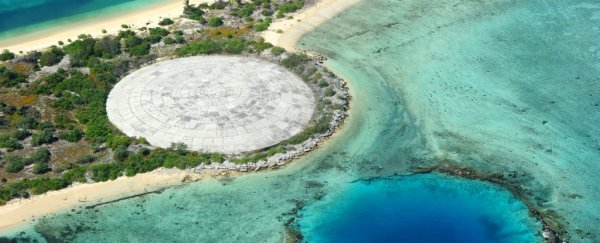In the Marshall Islands, locals have a nickname for the Runit Dome nuclear-waste site: They call it 'The Tomb'.
The sealed pit contains more than 3.1 million cubic feet (87,800 cubic meters) of radioactive waste, which workers buried there as part of efforts to clean hazardous debris left behind after the US military detonated nuclear bombs on the land.
From 1977 to 1980, around 4,000 US servicemen were tasked with cleaning up the former nuclear testing site of Enewetak Atoll. They scooped up the contaminated soil, along with other radioactive waste materials such as military equipment, concrete, and scrap metal.
It all went into the Runit Dome, which the servicemen then covered with concrete.
In total, the crater holds enough radioactive waste to fill 35 Olympic-sized swimming pools. Most of that is irradiated soil carrying plutonium, an isotope that can cause lung cancer if inhaled.
But as seas have gotten higher in the area – the water has risen about 7 millimetres per year since 1993 – water has begun to seep into the soil beneath the dome.
Unlike the sealed dome on top, the bottom of the pit was never lined with concrete. So now, rising tides threaten to submerge the tomb – or crack it open.
The Runit Dome is chipping and cracking
Prior to the nuclear tests in the 1940s and 1950s, residents of Enewetak Atoll were exiled from their homes and relocated to nearby islands. Today, only three of the atoll's 40 islands have been dubbed safe for human habitation. They are currently home to around 650 residents.
The island that hosts Runit Dome remains unoccupied.
In 2013, the US Department of Energy reported that radioactive materials could be leaking from the dome into the marine environment, but said such an occurrence would "not necessarily lead to any significant change in the radiation dose delivered to the local resident population."
But sea levels around the Marshall Islands are rising. By 2030, they could be between 1.2 and 6.3 inches (3 cm to 16 cm) higher than they are now, resulting in more storm surges and coastal flooding. By 2100, the dome could be submerged in water.
Locals fear that mounting damage to the structure could present a new set of health risks.
The dome recently began to crack and chip, increasing the odds that strong waves could force the structure open. A disaster like that would send even more radioactive waste into the nearby ocean or lagoon, which could even force locals to leave the island once again.
"If it does [crack] open, most of the people here will be no more," Christina Aningi, a teacher on Enewetak Atoll, told the Australian Broadcasting Corporation. "This is like a graveyard for us, waiting for it to happen."
Scientists don't know if the dome's radiation levels are harmful
Ken Buesseler, a marine radiochemist who is planning to sample the soil near the dome, recently told Insider that the concern about radiation levels could be overblown.
"There is cesium in everything you eat, plutonium in everything you eat and drink," he said.
Residents of Enewetak Atoll would have to inhale the leaked plutonium, or be exposed to contaminated water through an abrasion, to experience adverse health consequences.
But scientists are still studying the effects of radiation exposure on the islands overall.
"You can't taste or smell or touch or feel it," Buesseler said. "So it's kind of this invisible thing that can harm you, and no one wants that."
This article was originally published by Business Insider.
More from Business Insider:
